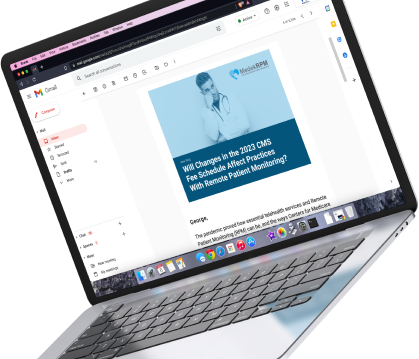
Time management, life balance and burnout are major issues facing healthcare providers. One study, published on the NIH website, reported 45.8% of physicians in the US would state they are having “burnout”.
One innovative tool for reducing over-commitments is the growing field of RPM (remote patient monitoring). This tool has been proven to increase patient loads while reducing time commitments from the healthcare provider. Furthermore, there is a huge benefit in the large reduction of hospital readmissions. A decrease of 50-70%.
Remote patient monitoring allows patients with chronic conditions to have daily readings of their health (blood pressure, glucose levels, blood oxygenation, weight) taken in their homes and sent through an encrypted cloud to their healthcare provider. These readings provide doctors allows healthcare professionals to see trends, spikes, and danger signs earlier, and engages the patient into their own healthcare.
When a physician wants to see a chronic care patient multiple times throughout a calendar year, it is often to see if the healthcare plan is working. A patient may make 3-4 office visits a year. More than this is often a major obstacle for patients. Yet, this often provides a doctor with only 3-4 readings of vital statistics on which to judge the effectiveness of treatment, medication or plan.
Trying to schedule and staff and fulfill 3-4 office visits for each chronic care patient can overwhelm a medical practice’s staff. It can limit the number of patients a practice can manage. It can be costly for the practice. For the doctor, it takes more of their valuable time.
Remote patient monitoring still requires one annual, in-office visit a year. The twelve months of monitoring provides the medical practice with twelve months of revenue. (RPM is covered by Medicare and most health insurance plans for patients with chronic conditions). While the monthly revenue is lower than the revenue from an office visit, twelve months of monitoring generates more revenue than 3-4 office visits.
There are huge medical benefits from RPM. Any sudden changes in daily readings are quickly observed and the doctor is immediately notified. This is part of the reason why RPM has caused a 50-70% in hospital readmissions. The effectiveness of medications can be more clearly seen with 365 readings a year, as opposed to 4 readings.
Many patients prefer to have readings taken in their home. The cost in time and resources to arrange travel to a doctor’s office, and the possible exposure from others makes repeated doctor visits a challenge to many with chronic conditions. Having a medical device in their homes often encourages patients to be more involved in their healthcare. Patients who are more engaged, have better health outcomes, and show greater retention to a medical practice.
For the physicians who are experiencing burnout, RPM offers many benefits. It takes less time to review 12 months of daily readings, than to sit with a patient 3-4 times a year. Additionally, a physician needs to keep records and notes of each of those office visits. The physician may also be involved with the scheduling, re-scheduling, and staffing of each of the office visits.
RPM produces more available time for the physician. That time can be used to prevent burnout, reduce stress, or if there is no burnout, then the time can be used to attend to more patients, growing the medical practice. The available time can be spent with critical patients, instead of repeating the same steps with chronic care patients. RPM helps chronic care patients from becoming critical care patients.
The field of RPM is growing rapidly, mainly because of its many benefits. It benefits patients with fewer hospital readmission, more engagement, and immediate attention to any sudden changes, spikes or trends in their personal health.
It benefits medical practices with more revenue with less staffing. And it benefits healthcare providers with more patient data for adapting medical health plans. Personally, it gives providers the ability to serve more patients using less time.
More time is what our healthcare providers need. When nearly half of all physicians say they are experiencing burnout. We need to find ways to help those who help us with our health.
Contact a Medek RPM representative today to see how much data, revenue and time you can gain with an RPM program. Medek RPM is one of the fastest growing RPM companies in the US. Connect today, because you are too busy to wait.





